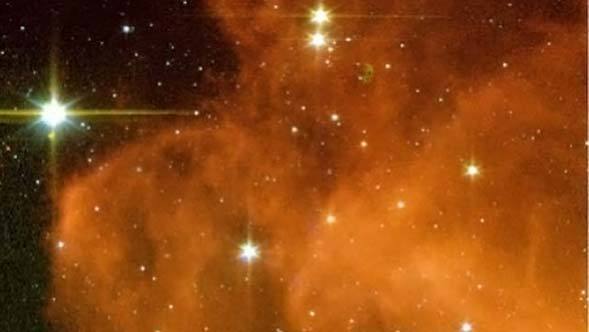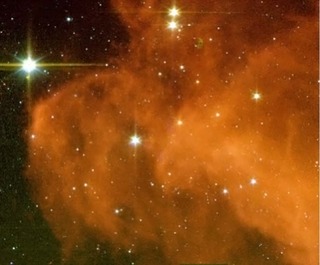
News Release • May 19th, 2006 • feature06-15 •
Written by Linda Vu
Spitzer Science Center
Eight hundred light-years away in the Orion constellation, a gigantic murky cloud called the "Witch Head Nebula" is teeming with dust-obscured newborn stars waiting to be uncovered.
In less than two hours of observations with the dust-piercing infrared eyes of NASA's Spitzer Space Telescope, a team of high school science teachers and students nearly quadrupled the number of known stars in the Witch Head's "pointy chin" alone. Now, they've been granted 11 more hours on Spitzer to scan the entire nebula for stellar embryos. They will also try to determine if the region's star formation is being triggered by strong winds from a nearby supergiant star named Rigel.
"Seeing newborn stars that no one had seen this clearly before was thrilling," said Cynthia Weehler, a science teacher at Burbank High School in San Antonio, TX.
"It's exciting to be engaged in the process of science where you are not merely studying astronomy in a historical sense, but rather you are making the significant contributions that will one day become scientific history," adds Timothy Spuck, a science teacher at Oil City Area Senior High School in Oil City, Penn.
Spuck and Weehler are just two of five high school science teachers from across the country hunting for stellar embryos in the region. The teachers are participants in the Spitzer Space Telescope Research Program for Teachers and Students. As part of the program, the teachers attended workshops and wrote a joint proposal for time on Spitzer. They conducted observations in early 2005, and that summer invited some of their brightest students to the Spitzer Science Center at the California Institute of Technology (Caltech) in Pasadena, Calif., to analyze the data with professional astronomers.
"The most important thing I learned while visiting the Spitzer Science Center is that science isn't something that can be taught from a text book, it's something that you learn only by doing it yourself," said Brittany Ehrhart, a student at Oil City Area Senior High School.
Ehrhart's classmate David Bowser II notes that his visit to the Spitzer Science Center taught him how to "analyze the pictures from the telescope and to plot the data to help classify the young stars."
"I wouldn't change a thing about my experience," said Bowser. "If I had the opportunity to do it again, I would, and many other students should have the opportunity as well."
"What excites me most about this program is the enthusiasm of the teachers and students involved. They are not only observing for themselves, they are sharing their experiences and resources with other teachers in their school districts and states," said Dr. Thomas Soifer, Spitzer Science Center director and professor of physics at Caltech.
In January 2006, the team presented their first set of observations in a poster paper at the 207th American Astronomical Society meeting in Washington DC. The meeting was one of the largest professional astronomical gatherings in history.
"Being able to present our project at the AAS was a chance to see how interested research scientists are in education," said Weehler. "They are committed to it, knowing that future research depends on students understanding of science, how research is done, and being as excited by it as they are."
"If we as a country want to remain in our currently leading role in the fields of science and technology, we need to inspire more people from the younger generation to join the field," adds Soifer. "This program is a meaningful way for NASA to help students understand the scientific process and decide on pursuing science as a long-term career goal."
New stars discovered by the teachers and students will be added to the Spitzer Science Center archives for astronomers across the community to reference in the years to come. Meanwhile, many of the teachers will use the Spitzer data as a teaching supplement in their classes.
The high schools involved in this project are: Lincoln High School in Stockton, Calif.; Phillips Exeter Academy in Exeter, N.H.; Luther Burbank High School in San Antonio, Tex.; Bassick High School in Bridgeport, Conn.; and Oil City Area Sr. High School in Oil City, Penn.
"Being part of the program has given me confidence that I can learn how science works. I didn't know I could understand research until I got this chance. I think the program is great and that more students should be able to do this," said Jessica Herrera, a senior at Luther Burbank High School.





